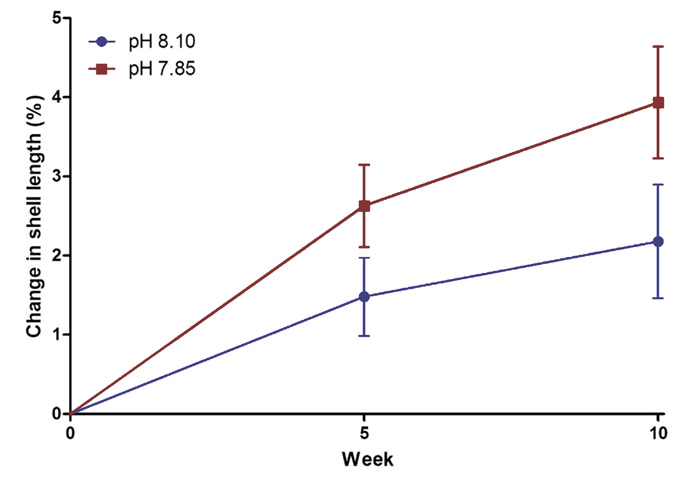| Follow @co2science |
Paper Reviewed
Leung, J.Y.S., Russell, B.D. and Connell, S.D. 2017. Mineralogical plasticity acts as a compensatory mechanism to the impacts of ocean acidification. Environmental Science & Technology 51: 2652-2659.
Marine species are thought by climate alarmists to be particularly vulnerable to so-called ocean acidification (OA). As atmospheric CO2 concentrations increase in the future -- and as the seawater of the world's oceans correspondingly decrease -- they suggest that many marine species will be harmed via impaired growth, metabolism, feeding, calcification and/or survival. However, as more and more detailed and sophisticated studies are conducted on this topic, evidence is mounting that OA concerns are exaggerated, and perhaps wholly unfounded.
The latest study to illustrate this fact comes from the work of Leung et al. (2017). For their contribution to the topic they subjected a marine gastropod (Austrocochlea constricta) to normal (pH = 8.10) and reduced (pH = 7.85) seawater pH conditions for a period of ten weeks, while analyzing a number of performance and growth-related properties during and at the end of their experiment, including respiration rate, feeding rate, somatic growth and shell growth. They also analyzed shell mechanical and geochemical properties, which included shell hardness, elastic modulus, amorphous calcium carbonate, calcite to aragonite ratio and magnesium to calcium ratio.
In discussing their findings, Leung et al. state that "despite minor metabolic depression and no increase in feeding rate, shell growth was faster under OA conditions," with shell lengths increasing by approximately 80 percent in the reduced pH treatment (see figure below) relative to ambient conditions. Another surprise was noted in measurements of shell hardness, which were also found to increase under OA conditions, and by a whopping 140%! Thus, not only did "dreaded" OA increase shell growth, but it produced shells that were harder and less likely to undergo dissolution -- which is a win-win scenario for the future.
Commenting on these and other of their findings, the team of three researchers identify mineralogical plasticity (the biologically-induced changing of shell mineralogy to favor precipitation of calcite over energy intensive aragonite) as the underlying mechanism that enables A. constricta to maintain calcification and overall fitness under OA conditions. This adaptive response, in the words of Leung et al., has previously "been recognized [to occur] on the geologic time scale when the physicochemical conditions shifted between 'aragonite sea' and 'calcite sea' due to the change in temperature, pCO2 concentration, or Mg/Ca of seawater (Harper et al., 1997; Hautmann, 2006)."
Finding such facts encouraging, the scientists conclude by stating that "mineralogical plasticity may act as a compensatory mechanism to maintain overall performance of calcifying organisms under OA conditions and could be a cornerstone of calcifying organisms to acclimate to and maintain their ecological functions in acidifying oceans." And that would suggest that predictions of marine species' demise due to OA are not nearly as likely as most alarmists make them out to be.

Figure 1. Percentage change in shell length of A. constricta across the 10-week exposure period at different pH levels. Source: Leung et al. (2017).
References
Harper, E.M., Palmer, T.J. and Alphey, J.R. 1997. Evolutionary response by bivalves to changing Phanerozoic sea-water chemistry. Geology Magazine 134: 403?407.
Hautmann, M. 2006. Shell mineralogical trends in epifaunal Mesozoic bivalves and their relationship to seawater chemistry and atmospheric carbon dioxide concentration. Facies 52: 417?433.
Posted 27 June 2017



